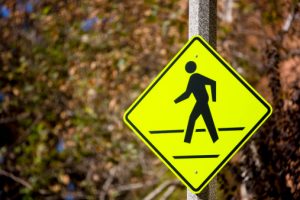Pedestrian Laws in Virginia, An Attorney Discusses

It is believed by many that pedestrians have the right way. Although this may hold true as your own personal theory or as a matter of courtesy, it is not true as a matter of law. The truth is that a pedestrian’s rights vary greatly depending on where they are and the exact location of their movements or crossing the street and traffic. Some of these rights are common sense, such as yielding to a pedestrian crossing in a crosswalk, but some are not. Particularly in the State of Virginia.
Pedestrian laws and regulations apply to the use of highways, roadways, sidewalks, and crosswalks. Of course, pedestrians have the right of way on sidewalks and are even required to use them in lieu of a roadway whenever a sidewalk is accessible. If a sidewalk is not available, the pedestrian is required to stay to the furthest left of the roadway, facing oncoming traffic or on the shoulder if it is wide enough to allow the pedestrian to pass safely. See Va Code § 46.2-928.
Like most states, Virginia requires vehicles to yield to pedestrians in crosswalks and requires pedestrians to use crosswalks whenever they are available. This is only easy to follow if we assume all crosswalks are conspicuously marked. Most crosswalks are easily identifiable because they are painted or otherwise marked. But what about unmarked crosswalks? Yes, there is such a thing. An “unmarked crosswalk” occurs anywhere sidewalks meet and roadways intersect. An intersection is a good identifier. Pedestrians are legally required to use these crosswalks in the same manner as marked crosswalks. However, because these crosswalks are much more difficult to identify, people assume that they are not crosswalks at all. If you are a driver under this assumption, it could lead to fatal consequences. This is why it is always important to be on the lookout for these “hidden” crosswalks. Remember where sidewalks meet is usually not in the middle of a block, but at intersections.
A pedestrian’s right to cross in a crosswalk is not absolute. Pedestrians are responsible for paying attention at crosswalks and heeding the pedestrian control or traffic signals in place. See Va Code §46.2-923. Furthermore, Virginia law prohibits a pedestrian from “carelessly” or “maliciously” interfering with the orderly passage of vehicles (See Va Code §46.2-923) and from stepping onto a highway where the pedestrian cannot easily be seen by vehicles. See Va Code § 46.2-926. An example of this restriction would be stepping onto a highway where you are obstructed by a parked truck near the curb. The restriction does not apply, however, when you are stepping into a highway to enter a safety zone or board public transportation. In this event, you would be required to cross the highway using right angles only. The safest way to approach this is to always be on the lookout and never assume that you have been seen by someone in a moving vehicle.
A number of people walk for exercise or leisure while others walk as a matter of necessity in order to commute. To the extent possible, you should always plan your walks. This includes both your route of travel, made easy through the use of apps, and the time of day, keeping in mind the shorter hours of daylight during the fall and winter months. Avoid walking with headphones or earbuds, as they may distract you or drown out the sound of a honking car or the blazing sirens of a firetruck. You should also never attempt to hitchhike or hail a taxi while in a roadway. Aside from being incredibly dangerous, Virginia law prohibits anyone from standing or stopping in a roadway for the purpose of soliciting transportation. See Va Code § 46.2-929.
Experts offer the following tips that are best practices to stay safe as a pedestrian and to avoid injuring a pedestrian if you are a driver:
For pedestrians:
- Use sidewalks and marked crosswalks whenever possible.
- Press the pedestrian signal button and wait for the walk signal.
- Always stop at the curb and look left, right and left before crossing a street.
- Watch for cars turning in or leaving driveways.
- Wear light or bright colored clothing.
- Pay attention and take off headphones while walking – no texting or playing games.
For drivers:
- Always stop for pedestrians.
- Follow traffic signs, signals and markings.
- Don’t run red lights.
- Observe posted speed limits. Speeding only makes it more difficult to stop for pedestrians.
- Keep your eyes on the road. It’s illegal to use a handheld phone/device or text while driving.
Observing these regulations and suggestions will not only help keep you safe, but they will greatly determine your rights in the event you are involved in a pedestrian-motor vehicle collision. As a pedestrian, you are much more vulnerable to serious injury as you have nothing to protect or shield your body from the impact.
If you or a loved one has been harmed in an accident, we invite you to set up a free consultation by clicking on this link. These consultations are designed to help us establish the facts of your claim, evaluate your potential for compensation and develop the best strategy to help you. Your free consultation is also an opportunity for you to ask us any questions you may have about your legal rights and figure out if we're the right fit for you. And best of all, if you decide to hire us to represent you, you only have to pay if we win your case. That's because the Law Offices of Stuart L. Plotnick, LLC in Rockville, Maryland, works on a contingency fee basis. There are no hidden fees, no surprises.

